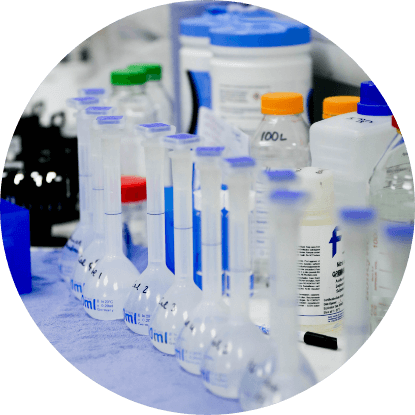
Chemical testing is vital in biological safety assessment, for reducing toxicological risks to human health and maintaining regulatory compliance. 20/30 Labs is an ISO 17025 UKAS accredited lab that has over 15 years of experience in chemical water analysis, both organic and inorganic, that can help you navigate the requirements and provide the relevant testing.
We have state-of-the-art equipment including ICP-MS, spectrophotometry, TOC detection technology, and a discrete analyser. Our ICP-MS (iCAP Qnova) uses an inductively coupled plasma source (argon) to atomise a sample and measure it using mass spectrometry. This is an elemental analysis technique, and 20/30 labs can offer daily long-term trace elemental analysis without drift. The spectrophotometer we have on-site is pre-programmed for over 200 test kits, we can quantify your sample with these, or any available colorimetric assays.
| Test Type | Description | Limit of Detection |
|---|---|---|
| pH | pH of a solution is a logarithmic scale measured using a calibrated pH probe based on the concentration of H+ ions. |
pH 2 – 13 |
| Conductivity | Conductivity, influenced by ion concentration and sample temperature, is measured directly using a calibrated probe with known conductivity solutions. |
10 – 112000 uS/cm |
| Hardness | Hardness is the process of determining the mineral content or concentration of certain ions to assess the water’s suitability for various purposes. |
10 – 300 mg/l as CaCO3 |
| Total Organic Carbon | 0.03 ppb – 50 ppm | |
| Endotoxin | 0.005 – 0.50 Eu/ml Or 0.05 – 5.0 Eu/ml | |
| Nitrate | 0.44 to 2.5 mg/l | |
| Nitrite | 0.0012 to 2.5 mg/l | |
| Total Organic Nitrogen | To measure total organic nitrogen (TON), nitrate is converted to nitrite, which is then reacted to form a pink dye. The absorbance of the dye at 540 nm is measured and correlated with TON concentration using a calibration curve. Colorimetric method. |
0.1 to 2.5 mg/l |
| Ammonia | 0.0016 to 1.0 mg/l | |
| Chloride | The thiocyanate ions released react in an acid solution with iron (III) nitrate to form a red/brown iron (III) thiocyanate complex. The resulting intensity of the stable colour produced is measured spectrophotometrically at a wavelength of 480 nm and is related to the chloride concentration by means of a calibration curve. |
0.349 – 500 mg/l |
| Phosphate | 0.036 to 4.58 mg/l | |
| Silicates | 0.05 to 5.0 mg/l (as SiO2) | |
| Total Dissolved Solids | Total dissolved solids are classed as dissolved ions, including salts, minerals, and metals, that can be found in water sources. |
|
| Fluoride | 0.05 – 5.0 mg/l | |
| Sulphate | Sulphate ion is precipitated in a strongly acid medium with Barium Chloride. The resulting turbidity is measured photometrically at 405 nm and compared with appropriate calibration standard solutions. Aquakem and Gallery application uses 420 nm. Colorimetric method. |
0.26 to 100 mg/l |
| Oxidisable Substrates | This test measures the ability of water to be oxidised by boiling with acid and an oxidiser chemical (potassium permanganate). |
N/A |
| Residue on Evaporation | The sample is evaporated to dryness and the residue is weighed. |
|
| ICP Metals (Be, B, Na, Mg, Al, K, Ca, Cr, Mn, Fe, Ni, Cu, Zn, As, Se, Mo, Ag, Cd, Sb, Ba, Hg, Tl, Pb, Ti) | Use of the ICP-MS for the analysis of metals. The sample is acidified, and internal standards are added and then the sample is introduced into the ICP-MS. The amount of each metal in the sample is determined using standards of known concentration. |
<0.0001 mg/l |
| Chemical Residue | SOP L029 by PAA, TOC or Conductivity |
Depending on the method |
| Sulphate Reducing Bacteria | Associated with taste/odour problems and microbially induced corrosion in water systems. |
Present/Absent |
| Nitrate Reducing Bacteria / Denitrifying Bacteria | Present/Absent | |
| Turbidity | This test measures the cloudiness/opacity of a water sample. It is reported in units of FAU |

If you have any questions or would like to learn more about our services, please contact us. We would be happy to discuss your specific needs and provide you with a quote.